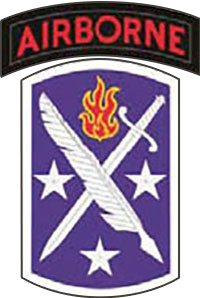DOWNLOAD
On 16 March 2006, Lieutenant General Robert W. Wagner, the U.S. Army Special Operations Command commanding general, signed the activation document authorizing the formation of the 95th Civil Affairs Brigade as a provisional unit.1 The unit moved from provisional to active status on 16 March 2007. The need for an active duty Civil Affairs brigade had not been discussed since 1991 following Operation DESERT STORM, but was finally approved because of the 2006 Quadrennial Defense Review.2 After one year as a provisional unit, the 95th Civil Affairs Brigade (Airborne) will become the only active component Civil Affairs brigade within the Department of Defense. Its mission is to provide operational and tactical Civil Affairs support to special operations forces and contingency forces. Over the next several years, the brigade will expand from one operational battalion, the 96th, to four. The new battalions will be the 91st, 97th, and 98th Civil Affairs Battalions, all stationed at Fort Bragg, North Carolina.3 On 17 August 2006, Colonel Ferdinand Irizarry II officially assumed command of the brigade in a ceremony at Meadows Field, Fort Bragg.4
The history of 95th Civil Affairs Brigade is one of a series of activations and deactivations since it was formed as the 95th Military Government Group on 25 August 1945 at the Presidio of Monterey, California. The headquarters deployed to Japan for occupation duty and to Korea for combat.5 After 1952, the headquarters did not deploy. However, its two subordinate units, the 41st and 42nd Military Government Companies, deployed on various missions supporting units based in the United States, including the XVIII Airborne Corps. The 95th Civil Affairs Group’s subordinate 41st Civil Affairs Company supported Operation MERCY (Hungarian refugee resettlement), Operation POWER PACK (the Dominican Republic), and was later detached to serve in Vietnam.6 The 95th Civil Affairs Group headquarters supported the Civil Affairs School at Fort Gordon, Georgia, and the Special Warfare Center and School at Fort Bragg.
The article may seem sketchy to many readers—this is intentional. Part of this article’s intent is to solicit history from veterans of the 95th Civil Affairs Brigade and its subordinate units, whether they served the country in peace or in war. A secondary intent is to remind soldiers of the importance of preserving their unit’s history for the future.
STATEMENT OF SERVICE
Headquarters And Headquarters Company 95th Civil Affairs Brigade
- Constituted 25 August 1945 in the Army of the United States as the 95th Headquarters and Headquarters Detachment, Military Government Group and activated at the Presidio of Monterey, California.
- Inactivated 30 June 1946 at Kurume, Japan.
- Redesignated 7 September 1948 as the 95th Military Government Group.
- Activated 29 October 1948 at Fort Bragg, N.C.
- Inactivated 28 October 1951 at Pusan, Korea.
- Allotted 9 December 1954 to the Regular Army.
- Activated 9 February 1955 at Camp Gordon, Georgia.
- Reorganized and redesignated 25 June 1959 as the 95th Civil Affairs Group.
- Relocated to Fort Bragg, North Carolina, 8 July 1971.
- Assigned to the US Army Special Warfare School.
- Inactivated 21 December 1974 at Fort Bragg, N.C.
- Redesignated 14 March 2006 as Headquarters and Headquarters Company (Provisional), 95th Civil Affairs Brigade.
- Activated 16 March 2007 at Fort Bragg, N.C.
- Campaign Credit Participation
- Korean War
- First UN Counteroffensive
- CCF Spring Offensive
- UN Summer-Fall Offensive
95th Civil Affairs DUI

The Distinctive Unit Insignia (DUI) for the 95th Civil Affairs Group was originally approved on 27 March 1969. The DUI was redesignated for the 95th Civil Affairs Brigade on 26 July 2006. The symbolism for the DUI is in keeping with the history of Civil Affairs. Purple and white are the colors used to signify Civil Affairs. The Brigade’s three campaign awards for service in Korea are commemorated by the gold Korean Gate. The white scroll alludes to civil and military laws and the safeguarding of records. The globe refers to the unit’s capability to fulfill worldwide responsibilities in accomplishing its mission. Together with the red flash (lightning bolt), which denotes keenness in providing guidance and swift courageous action, the DUI signifies the Brigade’s successful performance of Civil Affairs functions in support of combat and post-combat phases of military operations.
95th Civil Affairs SSI

The Shoulder Sleeve Insignia (SSI) for the 95th Civil Affairs Brigade was approved on 15 August 2006 by the Department of the Army. The SSI is a purple rectangle arched at the top and bottom with a white border between three white stars and scarlet flames edged yellow-in-chief; a crossed white quill and sword points down. Above the insignia is the black “AIRBORNE” tab inscribed in scarlet. The symbolism of the patch is interesting. Purple and white are the traditional colors associated with Civil Affair units. The quill and sword with points down represent the transition from war and conflict to the post-combat phase of military operations. The flame, adapted from the torch of the Civil Affairs branch insignia, symbolizes guidance and enlightenment, yet also underscores the flames of war, the change to peace, and then the defense and enforcement of the peace. The three stars commemorate the 95th Civil Affairs Brigade’s campaign awards for service in Korea.
